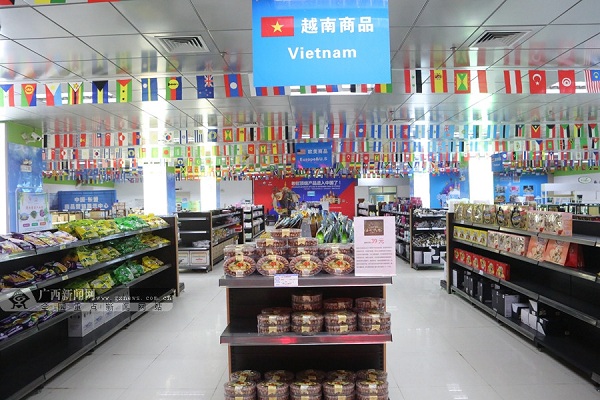
- Optimized and adjusted entry-exit policies speed up customs clearance of imports from ASEAN such as seasonal fruits on the China-Vietnam border trade corridor in Guangxi province
- The calibration of customs processes at the border has significantly reduced time for vehicle customs clearance, boosting cross-border trade
- More efficient customs clearance has unleashed the port’s potentials and, combined with financial reform, has improved cross-border trade and benefited people on both sides of the divide
Customs reform has boosted trade on the China-Vietnam border.
Youyiguan Port in Pingxiang City, Guangxi, has regained its previous bustle and vibrancy as a major trade corridor on the China-Vietnam border linking China to Association of Southeast Asian Nations (ASEAN) and the rest of the world since entry-exit policies were optimized and adjusted this year, according to a report carried by PR Newswire.
Due to climate differences, fruits from ASEAN members such as Vietnam and Thailand ripen earlier. For China, March is the peak season for importing fruits. As they are perishable, fruits require better logistics transport and warehousing, as well as quick customs clearance, said the report that cited the Management Committee of China (Guangxi) Pilot Free Trade Zone as its information source.
China border customs adjusts to the demands of the season. “While administering strict inspections, the Customs also implements measures such as ‘green channels’ for imported fruits, 7/24 pre-booked clearance, and rapid laboratory testing, which substantially shorten customs clearance time for ASEAN fruit imports,” Huang Feifei, chief of Youyiguan Customs Supervision Section I, was quoted as saying.
Pingxiang has 13 cross-border railway trains and 22 cross-border highway logistics lines capable of reaching more than 20 major hub cities in ASEAN countries, with a logistics network covering the Indochina Peninsula, said Wu Xiaohui, executive deputy director of the Chongzuo District Management Committee of China (Guangxi) Pilot Free Trade Zone.
In recent years, Guangxi has supported the infrastructure construction of key border ports, including adding more inspection checkpoints and larger cargo transfer sites. At the Youyiguan Port, it only takes about a minute or less for each truck to pass through the checkpoint.
“We have implemented a series of reform measures such as one-stop customs clearance, fully information-based intelligent customs clearance, ‘advance review and clearance of import and export goods, and checkpoint inspection and release’, resulting in a significant reduction of time for vehicle customs clearance,” Huang said.
The improved customs clearance efficiency has unleashed the port’s potentials, while Guangxi’s border financial reform has provided great convenience for cross-border trade.
In the China (Dongxing Pilot Zone) ASEAN Currency Business Center just steps away from Dongxing Port, a giant electronic screen displays the official exchange rate of the renminbi to Vietnamese dong. Today, the area has realized the currency exchange between renminbi and dong using direct quote.
Financial reform along the border has benefited the people of both China and Vietnam, and made cross-border trade more prosperous. In recent years, financial institutions such as Bank of Guilin have successively carried out cross-border transfer of renminbi and dong banknotes. As a result, cross-border finance has gradually expanded from merely a transaction settlement business to multiple fields.
“We have also launched special border-prospering and enriching financing products, such as ‘Huibian Loan’, ‘Hushi Loan’ and ‘Bianyi Loan,’ to meet the financial needs of residents engaged in cross-border trade, enterprises engaged in processing of imported materials, and purchasers,” said Wang Yunxiao, vice president of Guilin Bank.
Guangxi’s excellent border infrastructure is a guarantee for the rapid recovery of cross-border trade. Upgrading the border power grid has led to a leap in power supply capacity; acceleration of the construction of border communication infrastructure has realized 4G network coverage; the constantly improving highway network, the increasingly smoother logistics channels, and the like.
The Guangxi border infrastructure has been veritably enhanced due to multiple parties’ concerted efforts.
To facilitate investment, trade, cross-border capital flows and transport, the government of Guangxi Zhuang Autonomous Region issued recently a multi-pronged plan to further promote deepening of reforms and advance opening-up efforts.
Bai Lan, a full-time deputy director of the Office of China (Guangxi) Pilot Free Trade Zone, said the plan calls for the Guangxi Free Trade Zone to fully implement the pre-establishment national treatment plus negative management system list, and establish an operational and post-operational supervision management system that is compatible with the negative list management method.
At the time, promoting the opening-up of telecommunications, Internet, education and other fields in an orderly manner, as well as the vigorously developed new forms and models of foreign trade, such as cross-border e-commerce, offshore trade, and digital trade, the China (Guangxi) Pilot Free Trade Zone will hasten the exploration of institutional opening-up, the report said.
The free trade zone will create a Regional Comprehensive Economic Partnership Agreement demonstration project clusters implemented to high standards, benchmarked against the Comprehensive and Progressive Agreement for Trans-Pacific Partnership rules, and carry out pilot trials and risk stress tests in key areas such as trade in services, financial opening, and digital economy.








